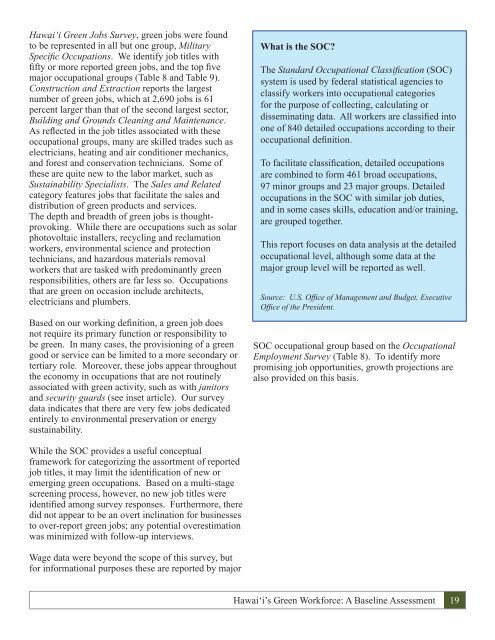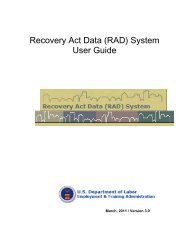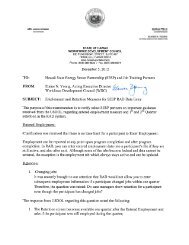Hawai i's Green Workforce A Baseline Assessment December 2010
Hawai i's Green Workforce A Baseline Assessment December 2010
Hawai i's Green Workforce A Baseline Assessment December 2010
Create successful ePaper yourself
Turn your PDF publications into a flip-book with our unique Google optimized e-Paper software.
<strong>Hawai</strong>‘i <strong>Green</strong> Jobs Survey, green jobs were found<br />
to be represented in all but one group, Military<br />
Specific Occupations. We identify job titles with<br />
fifty or more reported green jobs, and the top five<br />
major occupational groups (Table 8 and Table 9).<br />
Construction and Extraction reports the largest<br />
number of green jobs, which at 2,690 jobs is 61<br />
percent larger than that of the second largest sector,<br />
Building and Grounds Cleaning and Maintenance.<br />
As reflected in the job titles associated with these<br />
occupational groups, many are skilled trades such as<br />
electricians, heating and air conditioner mechanics,<br />
and forest and conservation technicians. Some of<br />
these are quite new to the labor market, such as<br />
Sustainability Specialists. The Sales and Related<br />
category features jobs that facilitate the sales and<br />
distribution of green products and services.<br />
The depth and breadth of green jobs is thoughtprovoking.<br />
While there are occupations such as solar<br />
photovoltaic installers, recycling and reclamation<br />
workers, environmental science and protection<br />
technicians, and hazardous materials removal<br />
workers that are tasked with predominantly green<br />
responsibilities, others are far less so. Occupations<br />
that are green on occasion include architects,<br />
electricians and plumbers.<br />
Based on our working definition, a green job does<br />
not require its primary function or responsibility to<br />
be green. In many cases, the provisioning of a green<br />
good or service can be limited to a more secondary or<br />
tertiary role. Moreover, these jobs appear throughout<br />
the economy in occupations that are not routinely<br />
associated with green activity, such as with janitors<br />
and security guards (see inset article). Our survey<br />
data indicates that there are very few jobs dedicated<br />
entirely to environmental preservation or energy<br />
sustainability.<br />
While the SOC provides a useful conceptual<br />
framework for categorizing the assortment of reported<br />
job titles, it may limit the identification of new or<br />
emerging green occupations. Based on a multi-stage<br />
screening process, however, no new job titles were<br />
identified among survey responses. Furthermore, there<br />
did not appear to be an overt inclination for businesses<br />
to over-report green jobs; any potential overestimation<br />
was minimized with follow-up interviews.<br />
Wage data were beyond the scope of this survey, but<br />
for informational purposes these are reported by major<br />
What is the SOC?<br />
The Standard Occupational Classification (SOC)<br />
system is used by federal statistical agencies to<br />
classify workers into occupational categories<br />
for the purpose of collecting, calculating or<br />
disseminating data. All workers are classified into<br />
one of 840 detailed occupations according to their<br />
occupational definition.<br />
To facilitate classification, detailed occupations<br />
are combined to form 461 broad occupations,<br />
97 minor groups and 23 major groups. Detailed<br />
occupations in the SOC with similar job duties,<br />
and in some cases skills, education and/or training,<br />
are grouped together.<br />
This report focuses on data analysis at the detailed<br />
occupational level, although some data at the<br />
major group level will be reported as well.<br />
Source: U.S. Office of Management and Budget, Executive<br />
Office of the President.<br />
SOC occupational group based on the Occupational<br />
Employment Survey (Table 8). To identify more<br />
promising job opportunities, growth projections are<br />
also provided on this basis.<br />
<strong>Hawai</strong>ÿi’s <strong>Green</strong> <strong>Workforce</strong>: A <strong>Baseline</strong> <strong>Assessment</strong> 19
















